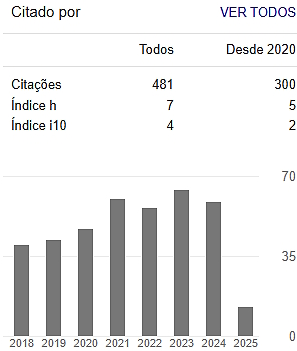PHYSIOVR: FERRAMENTA DE REALIDADE VIRTUAL APLICADO NA REABILITAÇÃO CARDIOVASCULAR
Keywords:
Doenças cardiovasculares, sistemas adaptativos, realidade virtual, Arduino.Abstract
Cardiovascular diseases (CVD) are the main causes of death in the world and many people who have CVD survive, making intervention measures that are effective in their cardiovascular rehabilitation (CVD) necessary. This article presents PHYSIOVR, a Virtual Reality (VR) tool that aims to assist in the treatment of cardiac patients during physical activities, making use of customized 3D virtual environments, aiming to improve functional capacity and cognitive involvement. The tool was evaluated through a usability questionnaire, obtaining a final average of 4,6 out of 5,0 points, and then it was evaluated by physical therapists, obtaining an overall satisfaction level of 9,1 ± 0,73.
Downloads
References
ALMEIDA, A. D. et al. Satisfação de fisioterapeutas frente à utilização de um software para reabilitação cardiopulmonar. In: ENCONTRO NACIONAL E ENSINO, PESQUISA E EXTENSÃO DA UNOESTE., 2021, Presidente Prudente. Anais [...]. Presidente Prudente: Unoeste, 2021. p. 657-664
BALISTA, V. G. PhysioJoy: sistema de realidade virtual para avaliação e reabilitação de déficit motor. In: WORKSHOP ON VIRTUAL, AUGMENTED REALITY AND GAMES, 12., 2013, São Paulo. Proceedings [...]. São Paulo: SBC, 2013.
CHUANG, T. Y.; SUNG, W. H.; LIN, C. Y. Application of a virtual reality-enchanced exercise protocol in patients after coronary bypass. Arch Phys Med Rehabil., v. 86, n. 10, p. 1929-1932, 2005. https://doi.org/10.1016/j.apmr.2005.05.003
FIALHO, P. H. et al. Efeitos de um programa de exercícios sobre a capacidade funcional de pacientes com cardiopatia chagásica crônica, avaliados por teste cardiopulmonar. Rev. Soc. Bras. Med. Trop., v. 45, n. 2, p.220-224, 2012.
GONSALVES, A. S.; SISCOUTTO, R. A. Solução de Baixo Custo para o Monitoramento De Sinais Vitais, em Tempo Real, Fazendo Uso de Sensores e Arduino. Revista Colloquium Exactarum., v. 12, n. 2, p. 102–118, 2020. https://doi.org/10.5747/ce.2020.v12.n2.e322
HOLMES, H. et al. Xbox Kinect™ represents high intensity exercise for adults with cystic fibrosis. J Cyst Fibros., v. 12, n. 6, p. 604-608, 2013. https://doi.org/10.1016/j.jcf.2013.05.005
KIMHY, D. et al. Use of Active-play video games to enhance aerobic fitness in schizophrenia: feasibility, safety, and adherence. Psychiatr Serv., v. 67, n. 2, p. 240-243, 2015. PubMed; PMID 26423100.
KITCHENHAM, B. et al. Systematic literature reviews in software engineering - a systematic literature review. Inf. Softw. Technol., Butterworth-Heinemann, Newton, MA, v. 51, n. 1, p. 7–15, jan. 2009. https://doi.org/10.1016/j.infsof.2008.09.009
LIKERT, R. A Technique for the Measurement of Attitudes, no. 136-165 in A Technique for the Measurement of Attitudes, publisher not identified. 1932; Disponível em https://books.google.com.br/books?id=9rotAAAAYAAJ. Acesso em: 10 nov. 2020.
NELSON, G. A. et al. Wii Fit Plus Exercise Training for Persons With Cardiac Disease. CardiopulmPhysTher J, v. 26, p. 73–77, 2015. https://doi.org/10.1097/CPT.0000000000000013
NIELSEN, J. Usability Engineering. Boston: Academic Press, 1993. https://doi.org/10.1016/B978-0-08-052029-2.50009-7
NOBLE, B. J. et al. A category-ratio perceived exertion scale: relationship to blood and muscle lactates and heart rate. Med SciSports Exerc, v. 15, n. 6, p. 523-528, 1983. https://doi.org/10.1249/00005768-198315060-00015
OPAS. Doenças crônico-degenerativas e obesidade: estratégia mundial sobre alimentação saudável, ativi-dade física e saúde. Brasília: Organização Pan-Americana da Saúde, 2003.
PESCATELLO, L. S. et al. Diretrizes do ACSM para os testes de esforço e sua prescrição. American College of Sports Medicine. 9. ed. Rio de Janeiro: Guanabara, 2014.
PIEGAS, L. S. et al. IV Diretriz da Sociedade Brasileira de Cardiologia sobre Tratamento do Infarto agudo do Miocárdio com Supradesnível do Segmento ST. Arq Bras Cardiol, v. 93, n. 6, Supl.2, p. e179-e264, 2009. https://doi.org/10.1590/S0066-782X2009000800003
RODRIGUES, G. A. et al. Acute cardiovascular responses while playing virtual games simulated by Nintendo Wii(®). J PhysTher Sci, v. 27, n. 9, p. 2849-2851, 2015. https://doi.org/10.1589/jpts.27.2849
RUIVO, J. A. Exergames and Cardiac Rehabilitation: a review. J Cardio pulm Rehabil Prev., v. 34, p. 2-20, 2014. https://doi.org/10.1097/HCR.0000000000000037
SILVA, A. K. F. et al. Cardiac risk stratification in cardiac rehabilitation programs: a review of protocols. Rev Bras Cir Cardiovasc, v. 29, n. 2, p. 255-65, 2014.
SILVA, R. R.; IWABE-MARCHESE, C. Using virtual reality for motor rehabilitation in a child with ataxic cerebral palsy: case report. Fisioter. Pesqui., v. 22, n. 1, p. 97-102, 2015.
SISCOUTTO, R. A.; COSTA, R. Realidade virtual e aumentada: uma abordagem tecnológica. São Paulo: SBC - Sociedade Brasileira de Computação, Livro do Pré-Simpósio X Symposium on Virtual and Augmented Reality João Pessoa – PB, 2008. Disponível em: https://www.academia.edu/39466116/Livro_do_Pr%C3%A9_Simp%C3%B3sio_X_Symposium_on_Virtual_and_Augmented_Reality. Acesso em: 4 jun. 2023.
TAVARES, C. N. et al. Uso do Nintendo® Wii para reabilitação de crianças com paralisia cerebral: estudo de caso. Rev Neurocienc., v. 21, n. 2, p. 286-293, 2013. https://doi.org/10.4181/RNC.2013.21.763.8p
UNITY 3D Unity User Manual (2018.1). Animator Component. Publication: 2018.1-002C. Built: 2018-05-18. Disponível em: https://docs.unity3d.com/Manual/class-Animator.html. Acesso em: 04 jun .2018.
VIEIRA, G. P. et al. Virtual Reality in Physical Rehabilitation of Patients with Parkinson’s disease. Rev. bras. crescimento desenvolv. hum., v. 24, n. 1, p. 31-41, 2014.
WHO. Cardiovascular diseases (CVDs). World Health Organization; 11 June 2021. Disponível em: http://www.who.int/news-room/fact-sheets/detail/cardiovascular-diseases-(cvds). Acesso em: 01 out 2021.
WHO. The top 10 causes of death World Health Organization; 9 Dec 2020. Disponível em: http://www.who.int/news-room/fact-sheets/detail/the-top-10-causes-of-death. Acesso em: 01 jun. 2021.
ZOCCOLILLO, L. et al. Video-game based therapy performed by children with cerebral palsy: a cross-over randomized controlled trial and a cross-sectional quantitative measure of physical activity. Eur J PhysReha-bil Med., v. 51, n. 6, p. 669-576, 2015.

